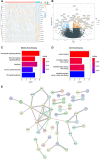Significant Prognostic Factor at Age Cut-off of 73 Years for Advanced Ovarian Serous Cystadenocarcinoma Patients: Insights from Real-World Study
- PMID: 38332982
- PMCID: PMC10849902
- DOI: 10.2147/IJWH.S439335
Significant Prognostic Factor at Age Cut-off of 73 Years for Advanced Ovarian Serous Cystadenocarcinoma Patients: Insights from Real-World Study
Abstract
Objective: The objective of this research was to determine the age cut-off for worse prognosis and investigate age-related differentially expressed genes (DEGs) in patients with advanced ovarian serous cystadenocarcinoma (AOSC).
Methods: In this research, we included a cohort of 20,846 patients diagnosed with AOSC, along with RNA-seq data from 374 patients in publicly available databases. Then we used the X-tile software to determine the age cut-off and stratified the patients into young and old groups. We utilized propensity score matching (PSM) to balance baseline between the young and old groups. Furthermore, we conducted an enrichment analysis of DEGs between the two age groups using Kyoto Encyclopedia of Genes and Genomes (KEGG) pathways and gene ontology (GO) to identify dysregulated pathways. To evaluate the potential prognostic value of the DEGs, we performed survival analysis, such as Kaplan-Meier analysis and Log rank test.
Results: We stratified the patients into young group (n=16,336) and old group (n=4510) based on the cut-off age of 73 years by X-tile software. Age over 73 years was identified as an independent risk factor for overall survival (OS) and cancer-specific survival (CSS). Next, we identified 436 DEGs and found that the neurotrophin signaling pathway and translation factor activity were associated with prognosis outcomes. Among the top 10 hub genes (RELA, NFKBIA, TRAF6, IRAK2, TAB3, AKT1, TBP, EIF2S2, MAPK10, and SUPT3H), RELA, TAB3, AKT1, TBP, and SUPT3H were found to be significantly associated with poor prognosis in old patients with AOSC.
Conclusion: Our study determined 73 years as the cutoff value for age in patients with AOSC. RELA, TAB3, AKT1, TBP, and SUPT3H were identified as age-related DEGs that could contribute to the poor prognosis of older patients with AOSC.
Keywords: advanced ovarian serous cystadenocarcinoma; age; prognosis; propensity score matching; real-world study.
© 2024 Zhang et al.
Conflict of interest statement
There are no conflicts of interest regarding the publication of this article.
Figures






References
LinkOut - more resources
Full Text Sources
Miscellaneous

